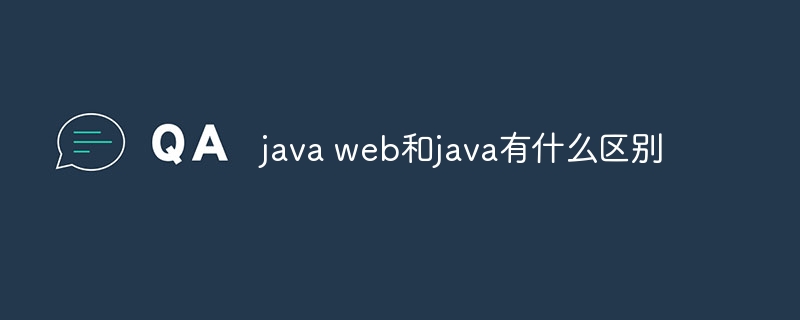The difference between web and java lies in definition and purpose, architecture and components, development process, application scenarios, technology stack and framework, etc. Detailed introduction: 1. Definition and purpose. Java is an object-oriented programming language that is platform-independent and can run on different operating systems. It is widely used in various fields, including desktop applications, mobile applications, and embedded applications. Java Web is a set of technologies developed based on the Java technology stack for building Web applications, including Java Servlet and so on.

The operating system for this tutorial: Windows 10 system, DELL G3 computer.
Java is a general programming language, and Java Web is a technology stack developed based on Java for building Web applications. The differences between Java and Java Web will be explained in detail below.
1. Definition and usage:
- Java: Java is an object-oriented programming language launched in 1995 by Sun Microsystems (now Oracle). Java is platform independent and can run on different operating systems. Java is widely used in various fields, including desktop applications, mobile applications, embedded systems, etc.
- Java Web: Java Web is a set of technologies developed based on the Java technology stack for building Web applications. It includes technologies and frameworks such as Java Servlet, JavaServer Pages (JSP), JavaServer Faces (JSF), and JavaServer Pages Standard Tag Library (JSTL). Java Web is used to develop server-side Web applications, which can handle HTTP requests, generate dynamic content, interact with databases, etc.
2. Architecture and components:
- Java: Java’s architecture is based on the Java Virtual Machine (JVM). Java applications usually contain components such as classes, interfaces, packages, etc., and can use Java standard libraries and third-party libraries to implement various functions.
- Java Web: The architecture of Java Web is based on the client-server model. It uses Java Servlet as the server-side component responsible for handling HTTP requests and generating dynamic content. JavaServer Pages (JSP) allow developers to mix HTML and Java code to generate dynamic web pages. Java Web can also use JavaBean, JSTL and other components to handle business logic and data display.
3. Development process:
- Java: The development of Java applications usually includes writing source code, compiling to bytecode and running. Java developers use the compiler and runtime environment in the Java Development Kit (JDK) to develop and run Java applications.
- Java Web: The development of Java Web applications typically includes writing code for Servlets, JSPs, and other components, as well as configuring the Web server. Java web developers use the Java Development Kit (JDK) and Java web containers such as Apache Tomcat to develop and run Java web applications.
4. Application scenarios:
- Java: Java is widely used in various application development, including desktop applications, mobile applications, embedded systems, etc. It is a general-purpose programming language that can be used to develop various types of applications.
- Java Web: Java Web is mainly used to develop server-side Web applications. It can handle HTTP requests, generate dynamic content, interact with databases, and more. Java Web applications can be used to develop various web applications, such as e-commerce websites, social media platforms, enterprise applications, etc.
5. Technology stack and framework:
- Java: Java has many technology stacks and frameworks to choose from, such as Java standard library, Spring framework, Hibernate framework, etc. . These technology stacks and frameworks provide rich features and tools to help developers develop Java applications more efficiently.
- Java Web: Java Web also has many technologies and frameworks to choose from, such as Java Servlet, JSP, JSF, Spring MVC, etc. These technologies and frameworks provide functions such as processing Web requests, generating dynamic content, and managing sessions, helping developers develop Java Web applications more conveniently.
In summary, Java is a general programming language that is widely used in various fields. Java Web is a technology developed based on the Java technology stack for building web applications. Java Web uses Java Servlet, JSP, JSF and other components and frameworks to process web requests, generate dynamic content, interact with databases, etc. Java and Java Web have differences in definition, architecture, development process, application scenarios, and technology stacks, but they can complement each other and enable developers to develop powerful applications.
The above is the detailed content of What are the differences between java web and java. For more information, please follow other related articles on the PHP Chinese website!
 带你搞懂Java结构化数据处理开源库SPLMay 24, 2022 pm 01:34 PM
带你搞懂Java结构化数据处理开源库SPLMay 24, 2022 pm 01:34 PM本篇文章给大家带来了关于java的相关知识,其中主要介绍了关于结构化数据处理开源库SPL的相关问题,下面就一起来看一下java下理想的结构化数据处理类库,希望对大家有帮助。
 Java集合框架之PriorityQueue优先级队列Jun 09, 2022 am 11:47 AM
Java集合框架之PriorityQueue优先级队列Jun 09, 2022 am 11:47 AM本篇文章给大家带来了关于java的相关知识,其中主要介绍了关于PriorityQueue优先级队列的相关知识,Java集合框架中提供了PriorityQueue和PriorityBlockingQueue两种类型的优先级队列,PriorityQueue是线程不安全的,PriorityBlockingQueue是线程安全的,下面一起来看一下,希望对大家有帮助。
 完全掌握Java锁(图文解析)Jun 14, 2022 am 11:47 AM
完全掌握Java锁(图文解析)Jun 14, 2022 am 11:47 AM本篇文章给大家带来了关于java的相关知识,其中主要介绍了关于java锁的相关问题,包括了独占锁、悲观锁、乐观锁、共享锁等等内容,下面一起来看一下,希望对大家有帮助。
 java web和java有哪些区别Sep 05, 2023 pm 02:14 PM
java web和java有哪些区别Sep 05, 2023 pm 02:14 PMjava web和java的区别在定义和用途、架构和组件、开发过程、应用场景、技术栈和框架等。详细介绍:1、定义和用途,Java是一种面向对象的编程语言,具有平台无关性,可以在不同的操作系统上运行,广泛应用于各种领域,包括桌面应用程序、移动应用程序、嵌入式系统等,Java Web是基于Java技术栈开发的用于构建Web应用程序的一套技术,它包括Java Servlet等等。
 一起聊聊Java多线程之线程安全问题Apr 21, 2022 pm 06:17 PM
一起聊聊Java多线程之线程安全问题Apr 21, 2022 pm 06:17 PM本篇文章给大家带来了关于java的相关知识,其中主要介绍了关于多线程的相关问题,包括了线程安装、线程加锁与线程不安全的原因、线程安全的标准类等等内容,希望对大家有帮助。
 Java基础归纳之枚举May 26, 2022 am 11:50 AM
Java基础归纳之枚举May 26, 2022 am 11:50 AM本篇文章给大家带来了关于java的相关知识,其中主要介绍了关于枚举的相关问题,包括了枚举的基本操作、集合类对枚举的支持等等内容,下面一起来看一下,希望对大家有帮助。
 详细解析Java的this和super关键字Apr 30, 2022 am 09:00 AM
详细解析Java的this和super关键字Apr 30, 2022 am 09:00 AM本篇文章给大家带来了关于Java的相关知识,其中主要介绍了关于关键字中this和super的相关问题,以及他们的一些区别,下面一起来看一下,希望对大家有帮助。
 java web和java有什么区别Aug 09, 2023 pm 03:22 PM
java web和java有什么区别Aug 09, 2023 pm 03:22 PMjava web和java的区别:1、开发层面,Java Web主要是Web应用程序的开发,Java则主要桌面应用程序或者命令行工具的开发;2、技术栈,Java Web需要掌握一系列相关的技术,Java则更偏向于Java核心语言的应用和开发框架的使用;3、架构模式,Java Web通常采用三层架构,Java则可以根据需求选择不同的架构模式;4、部署方式等等。


Hot AI Tools

Undresser.AI Undress
AI-powered app for creating realistic nude photos

AI Clothes Remover
Online AI tool for removing clothes from photos.

Undress AI Tool
Undress images for free

Clothoff.io
AI clothes remover

AI Hentai Generator
Generate AI Hentai for free.

Hot Article

Hot Tools

mPDF
mPDF is a PHP library that can generate PDF files from UTF-8 encoded HTML. The original author, Ian Back, wrote mPDF to output PDF files "on the fly" from his website and handle different languages. It is slower than original scripts like HTML2FPDF and produces larger files when using Unicode fonts, but supports CSS styles etc. and has a lot of enhancements. Supports almost all languages, including RTL (Arabic and Hebrew) and CJK (Chinese, Japanese and Korean). Supports nested block-level elements (such as P, DIV),

SublimeText3 Chinese version
Chinese version, very easy to use

Dreamweaver Mac version
Visual web development tools

EditPlus Chinese cracked version
Small size, syntax highlighting, does not support code prompt function

Safe Exam Browser
Safe Exam Browser is a secure browser environment for taking online exams securely. This software turns any computer into a secure workstation. It controls access to any utility and prevents students from using unauthorized resources.





